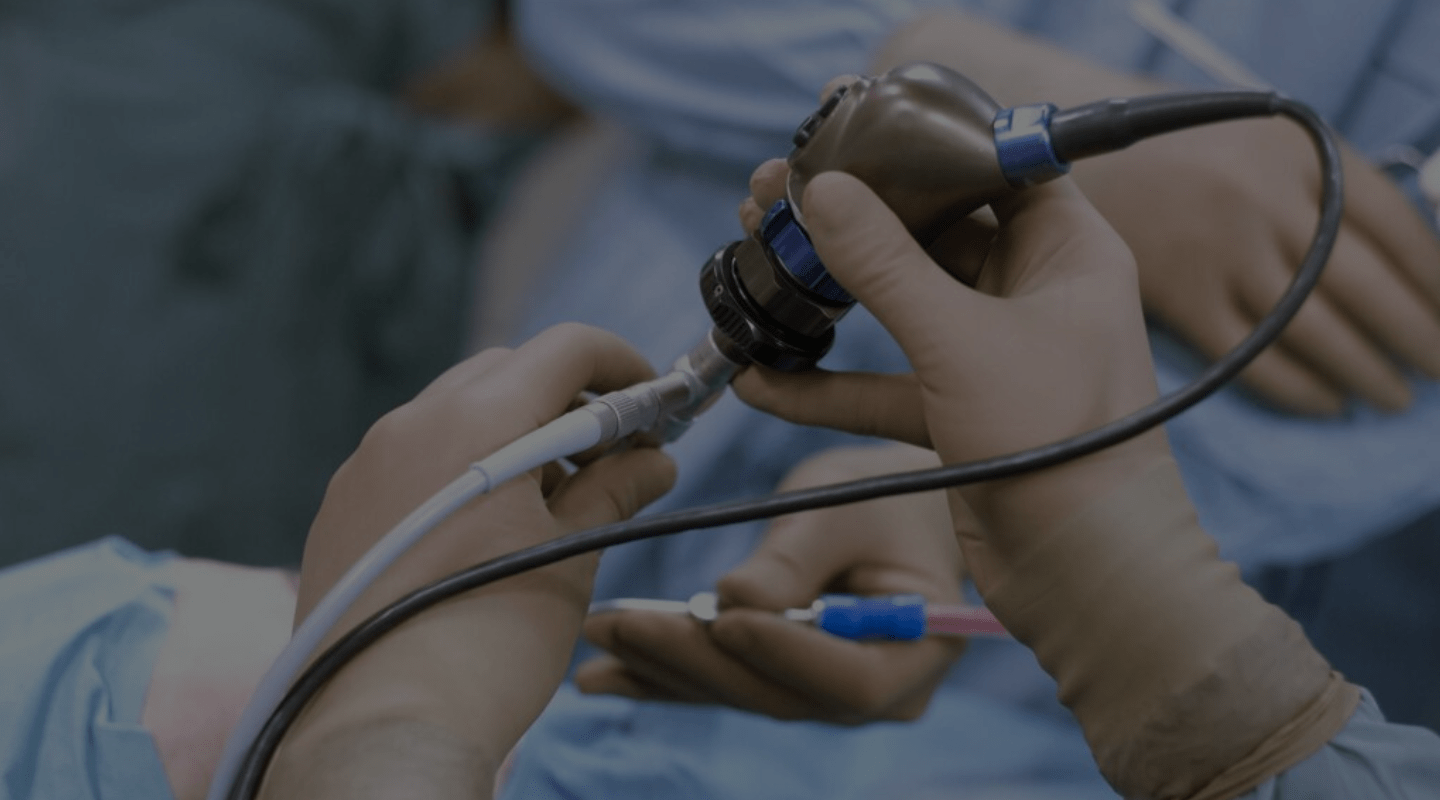
ERCP: Endoscopic Retrograde Cholangiopancreatography
Your ERCP in Tunisia at an affordable price
Opt for a medical stay with Tunisia Destination Santé and benefit from the expertise of our specialist doctors and the best healthcare facilities in Tunisia. Thanks to our tailor-made service, you will benefit from comprehensive support in a secure and comfortable setting.
How does it work?
What is Endoscopic Retrograde Cholangiopancreatography?
Endoscopic retrograde cholangiopancreatography (ERCP) is a procedure used to diagnose and treat certain diseases of the biliary tract, pancreas, and ampulla of Vater. The procedure involves inserting a special endoscope through the mouth, esophagus, and stomach into the duodenum, where the bile duct from the liver and the pancreatic duct empty into the same anatomical structure, the sphincter of the hepatopancreatic ampulla (sphincter of Oddi). During the procedure, the endoscopist inserts a thin tube and injects an opaque radiological substance (contrast medium) that allows radiological visualization of the biliary tract and/or the pancreatic duct.
What are the indications for performing an ERCP?
Endoscopic retrograde cholangiopancreatography (ERCP) is a medical examination used to visualize the biliary tract and pancreas. Its main objective is to diagnose and treat conditions related to these organs. ERCP is performed when specific indications are present, such as suspected gallstones, biliary tract obstruction, biliary tract stenosis, pancreatic or biliary tract tumors, bilio-pancreatic fistulas, liver or pancreatic dysfunction, and post-operative complications. The ERCP technique combines the use of an endoscope, which is inserted through the mouth to the ampulla of Vater, and the injection of a radiographic contrast agent to visualize the biliary tract and pancreas using X-rays. This examination provides precise information on the state of the biliary tract and pancreas, and can also be used to perform therapeutic procedures, such as biliary tract dilation or stone extraction. ERCP is an essential medical technique for the diagnosis and treatment of various conditions related to the biliary tract and pancreas.
What is the average cost of an ERCP?
The average cost of an endoscopic retrograde cholangiopancreatography (ERCP) can vary depending on several factors. The costs associated with an ERCP generally include several components. First, there are the costs related to the procedure itself, such as the fees of the gastroenterologist and the medical team assisting in the examination. These fees can vary depending on the geographical region and the medical facility where the ERCP is performed. Then, there are the hospitalization fees, as the ERCP is generally performed in a hospital setting. These fees may include the room, nursing care, medications, and other hospital services. Finally, it is necessary to consider the fees for additional examinations, such as laboratory tests or imaging examinations, which may be necessary before or after the ERCP. In Tunisia, the average cost of an ERCP can range from €1,500 to €3,500.
How to prepare for an ERCP?
An empty stomach allows for the best and safest endoscopic exploration. The patient undergoing an ERCP must have been fasting for at least 12 hours. The presence of food or food debris restricts the field of vision, which affects the diagnostic reliability of the procedure and, in case of vomiting, can favor the passage of food debris into the airways. During the pre-examination interview, it is essential that the physician be informed of any possible illnesses and/or allergies of the patient, of any medication taken, and of the possible presence of a pacemaker or other implantable device that could interfere with electromechanical instruments. If the patient is taking anticoagulant and/or antiplatelet drugs in anticipation of the examination, it may be necessary to suspend or replace them after consulting the responsible specialist. In particular clinical conditions, it may be necessary to use medications to restore adequate values of coagulation tests. In case of latex allergy, the endoscopy room may need to be specially equipped and special materials used. In anticipation of particular operative endoscopic procedures, based on the patient’s medical history, previously performed clinical-instrumental examinations and the presence of possible risk factors, and the opportunity to perform blood tests for the evaluation of the coagulation structure could be considered. This procedure always involves the use of appropriate premedication (sedatives, analgesics, and antispasmodics). To this end, a peripheral venous access is positioned, and heart rate, blood oxygen saturation, and blood pressure are monitored. If deep sedation is decided, the presence of the anesthesiologist will be necessary. The patient will undergo an anesthetic evaluation and will have to sign a specific and separate consent form proposed by the anesthesiologist. Any removable dental prosthesis must be removed before the examination.
How is an ERCP performed?
The ERCP usually lasts 30 to 60 minutes, is performed while fasting, during hospitalization, and involves deep sedation, with the endoscopist accompanied by an anesthesiologist. The anesthesiologist will provide you with additional information and ask for your specific consent. During the procedure, medication may be injected to slow down intestinal transit and facilitate endoscopic maneuvers. The diagnostic examination is performed by injecting a contrast medium through the opening of the ampulla of Vater into the biliary tract or pancreatic duct, depending on the organ to be examined. The X-ray images obtained are then developed. As the procedure involves the use of X-rays, which can harm the fetus, all women of childbearing age must be absolutely certain that they are not pregnant: a pregnancy test is necessary. The injection of contrast medium can induce allergic reactions that can be very serious in 1 in 100,000 cases.
The endoscope used for ERCP allows surgical procedures that, in the past, required a real operation. These procedures are:
- Opening of the bile and pancreatic ducts into the duodenum, performed by sectioning the ampulla of Vater and the sphincter of Oddi using a special type of electric scalpel;
- Extraction of stones from the biliary tract or pancreas;
- Insertion of a small plastic tube through the nose into the biliary tract or pancreatic duct to allow adequate drainage 24-48 hours after the procedure;
- Dilation of narrowed bile and/or pancreatic ducts (endoscopic plastic surgery);
- Insertion of a small plastic tube (removable) or a metal mesh stent (non-removable) into narrow sections of the bile and/or pancreatic ducts (stent implantation);
- Removal of new formations at the duodenal outlet of the biliary and pancreatic ducts;
- Drainage of cysts of pancreatic origin with stent implantation;
What is the recommended post-operative care after an ERCP?
After the procedure, the patient is monitored until full recovery from sedation. Post-sedation and sent to the ward. Further clinical follow-up will be indicated in the discharge report according to the following criteria according to the specific needs of the case. Abdominal pain may occur in the first 12 hours after the procedure. In the days following the ERCP, it is useful for the patient to check the color of their stools which, in case of hemorrhage, may become dark and foul-smelling. become dark and foul-smelling. In this case, it is essential to consult a physician to assess the problem.
What are the alternatives to ERCP?
The diagnostic alternatives to ERCP are respectively MRI cholangiography and echo-endoscopy. In certain particular cases, percutaneous transhepatic cholangiography (PTC) can be a diagnostic alternative, but it involves the use of X-rays. The therapeutic procedures alternative to PTC are mainly surgery and interventional radiology (percutaneous transhepatic cholangiography). The choice of each treatment option is made based on the advantages and disadvantages (complications, success rate, long-term results) that each procedure presents in relation to the pathology to be treated.
Our advantages


Contact and quote request for an ERCP
If you are tempted to have your ERCP as part of a general health check-up or for digestive disorders, trust the professionals of Tunisia Destination Santé. Our team is always at your disposal to assist and guide you through all the procedures. We accompany you step by step in the preparation of your file and the organization of your stay. Do not hesitate to contact us for more information and to request a free, no-obligation quote for your fibroscopy.
Your health, our priority.
Request your free quote.
Frequently Asked Questions
Long-term risks of ERCP include chronic pancreatitis, biliary strictures, and recurrent infectious complications. Although rare, strictures or scarring in the bile ducts may require further interventions.
ERCP can identify rare causes of obstructive jaundice, such as congenital abnormalities of the biliary tract, biliary parasites, or rare tumors. It allows direct visualization and biopsy of suspicious structures.
ERCP is very effective in treating post-surgical bile leaks by placing biliary stents or performing sphincterotomies to facilitate biliary drainage and allow healing.
ERCP can be used to extract or fragment intrahepatic gallstones, although this may require advanced techniques such as cholangioscopy or the use of laser lithotripsy.
Follow-up protocols include regular visits to the gastroenterologist, pancreatic function tests, and control imaging to monitor for pancreatitis recurrence or secondary complications.
In patients with altered biliary anatomy (such as after Whipple surgery), special techniques such as the use of guidewires, pre-cut catheters, or transanastomotic biliary-pancreatic approaches may be necessary.
Selection criteria include specific indications such as biliary atresia, recurrent pancreatitis, or congenital abnormalities of the biliary tract, and take into account the child’s weight and age to minimize risks.
ERCP is used to diagnose and treat post-liver transplantation biliary complications, such as anastomotic strictures or bile leaks, often by placing biliary stents.
Recent developments include thinner and more flexible instruments, real-time imaging guidance systems, and more efficient stone extraction devices such as mechanical and laser lithotripsy.
ERCP plays a key role in the management of biliary and pancreatic tumors by allowing tissue biopsy, stent placement to relieve biliary obstruction, and the application of local therapies such as phototherapy or radiofrequency.
